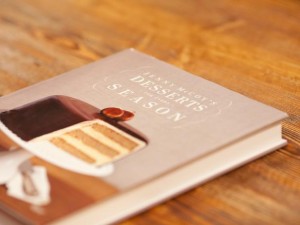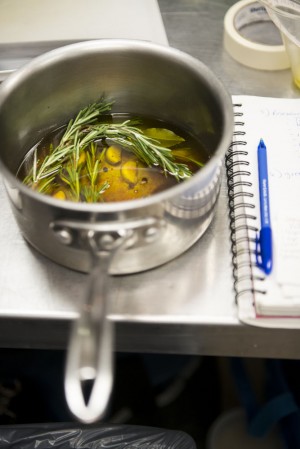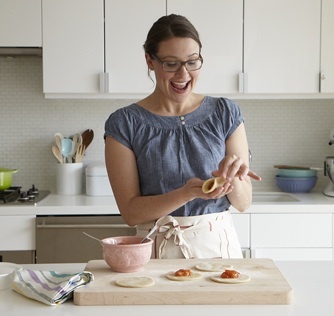As I finalize the contract details for my next cookbook(!), I thought this would be the perfect time to write about my efforts in securing a book deal, as well as the the process I like to use to write the books themselves. Rizzoli published my first cookbook, Desserts for Every Season, in September of 2013, to critical acclaim. However, it was only with the help of an incredible agent, editor, photographer, and cookbook design team that I was actually able to get the thing written.
Most aspiring authors have no clue of just how much time and effort goes into writing a cookbook. By the time an author has completed her manuscript, she is often wondering why in the world she signed up to write one in the first place. There are several planning and execution stages involved in writing a cookbook, the most important of which is securing a great team of people to work with. In my opinion, one simply cannot write a cookbook without the help of others. So in a kind of mini-series of blog posts for the ICE Blog, I am going to break down the process for you in four stages:
- Writing a Proposal
- Selling a Proposal
- Project Planning and Management
- Writing and Shooting Photos for a Cookbook
All of these phases include key partnerships, lots of thought and preparation, and knowledge that your cookbook will be a labor of love—not lots of money. And please keep in mind, if you truly want to write a cookbook, there are several ways to go about it. This is simply my advice, drawn from my personal experiences. I’ll be sure to keep it simple—the last thing I want is to deter anyone from achieving his or her dreams.
Part One: Writing a Cookbook Proposal
You can absolutely lose your mind before even putting pen to paper to draft a cookbook proposal. The concept is daunting. Like, really, really daunting. But if you break your proposal into small sections, you will find that getting over your fear of “OMG! How in the world am I supposed to write 40+ pages about an idea?” is a bit easier. Here’s a list of the nine sections I recommend including in your proposal, along with a little bit of advice on specific information to include.
1. Title Page – Include the “working title” of your cookbook; Author’s name; and the name, address, and contact information for your literary agent. If you don’t have a literary agent, that’s ok for now—do not let it stop you from completing your proposal. (We’ll discuss agents further in Part Two of the series.)
2. Table of Contents – You’ll write this last, after you’ve completed the proposal. It should only be one page long and include page numbers.
3. Overview – This is the part of the proposal where you want to SELL! SELL! SELL! your idea. It includes the following:
- Mission Statement – Pitch your idea here. For example, explain how your idea is an up-and-coming trend or is an older subject that has a proven audience. Explain why you are personally interested in your cookbook’s topic. Discuss some of the details: will it be for home cooks, professionals, parents, kids? Will your recipes require specialty equipment and ingredients, or be easy-to-use and accessible for all levels of cooks? Cite prominent magazines or websites that have written articles about your cookbook’s subject. Prove to the publisher that you’re "on to something" and your book will fill a gap in the cookbook market.
- Author Biography – This is where you shamelessly self-promote. Do not be shy. Include all of your relevant experience, accomplishments, and awards that you’ve received. Also include any past writing experience you may have—whether you're an avid blogger or have had recipes or articles published already. Make sure you describe your professional platform; if you are or were the chef at a prominent restaurant, have a huge social media following, or know editors that will write about your book, now is the time to mention it! Publishers prefer books written by authors that already have a following and can help sell the cookbook, so if you have outlets for the book to gain exposure, let them know.

- Front Matter – This information outlines the “front section” of your cookbook—all the stuff that fills the pages before you get to the recipes. Take a look at some of your favorite cookbooks for ideas, but be very, very brief in describing this section. All you need to do here is provide a simple list of the following:
- Copyright Page
- Dedication Page
- Table of Contents
- Foreword – Include one or more experts in the field that you know personally who might write a foreward for you. If you don’t have any, omit this from your list.
- Introduction – List points that you’d like to cover in your introduction. Perhaps a brief history of the subject, your personal relationship to the subject, and your favorite tips for success, etc.
- Ingredients and Equipment Guide – Most cookbook authors include this in a cookbook, but it’s not necessary. If you do want to include this in your front matter, write one to two bullet points about what information you plan to cover.
- Do note that all of the components in the Front Matter (other than the copyright page and table of contents) are optional. So tailor your front matter outline around your personal preferences: if you hate when cookbooks include ingredient guides, skip it!
- Outline of Chapters – Write one to two paragraphs about the flow of your cookbook. Tell your publisher how many recipes you want to include and how many photos you’d like per chapter. Perhaps you’d like the book to have illustrations, or maybe you’d like to include little sidebars on cooking tips and ingredient facts. Then list the chapters you plan to include, along with numbers and titles as you go along. (For example, a salad cookbook might go: 1-Leafy Greens; 2-Shaved Vegetables; 3-Whole Grains, etc.)
- Back Matter – This is the section that follows your recipes. Simply list the following:
- Resource Guide
- Acknowledgement Page
- Index
- Back Jacket Quotes – If you can list prominent authors, chefs, experts that you know personally and who will write a quote for the back of your book, include their names here. DO NOT make this stuff up. Many publishers will hold you to this list, as it is a very important element to the sales and marketing of your book.
 4. Market Analysis – This section isn’t necessary, but it certainly can’t hurt to write up. Whether you include this information in your proposal or not, you should definitely do your homework. You want a cookbook concept that doesn’t already exist or that isn’t a subject that is over-represented in the market. Publishers pick up books that will sell, so make sure you aren't proposing a title that already has a ton of competition, like "Cupcakes," for example.
4. Market Analysis – This section isn’t necessary, but it certainly can’t hurt to write up. Whether you include this information in your proposal or not, you should definitely do your homework. You want a cookbook concept that doesn’t already exist or that isn’t a subject that is over-represented in the market. Publishers pick up books that will sell, so make sure you aren't proposing a title that already has a ton of competition, like "Cupcakes," for example.
- Audience for Book – List all the categories of people you think will read or purchase your cookbook. Include internet-based booksellers, national bookstore chains, etc. But be brief, this is just a simple list.
- Comparable Titles – If books exist that are similar to your subject, list them. You need to include the author name, publisher, and one line that describes the book. Make sure that line subtly downplays the book. You don’t want the publisher to think it’s better than your idea!
5. Sample Chapter Introduction – Write a chapter introduction. It should be one to two double-spaced pages. Have friends read it and give you feedback. Make sure it is clear and concise. Read chapter introductions from your favorite cookbooks for guidelines about what sort of information you might like to include.
6. Sample List of Recipes – List all the chapters you previously mentioned in your Outline of Chapters and include three to four recipe ideas for each chapter.
- Sample Recipes – Include two or three fully written and edited recipes from your Sample List of Recipes. Take a look at recipes written in magazines or cookbooks for examples of how recipes are structured. Make sure they are easy to follow and that you have tested them carefully! Some editors will actually try your recipes. If they aren’t any good, guess who won’t be getting a return phone call?
 7. Selected Press Clips – If you or you work has ever been mentioned in the press, include clips here. Be sure you mention the name of the publication, author of article, publish date, and the entire article, including photography. Anywhere from three to five samples is good. Pick the press clips that highlight your work best.
7. Selected Press Clips – If you or you work has ever been mentioned in the press, include clips here. Be sure you mention the name of the publication, author of article, publish date, and the entire article, including photography. Anywhere from three to five samples is good. Pick the press clips that highlight your work best.
8. Selected Writing Samples – If you are a blogger, this is a great place to include two or three of your favorite posts and photos. Or, if you’ve ever been a guest writer, include your published articles here.
9. Sample Images – This section is completely optional, but I love including it in my proposals. Beautiful images of food will help sell your proposal. If you have great images that you have shot yourself, use those first. Otherwise, you can pull images from the Internet and call them “inspirational” images. Be sure to credit the photographers and mention your sample images are meant to give your publisher a sense of the aesthetic and design you’d like your book to have.
So there you have it! Just pull these elements together, and next thing you know, you have a proper cookbook proposal. If you’re anything like me, you’ll want to write your Outline of Chapters and Sample List of Recipes and call it a day. But don’t do that. There is nothing wrong with starting on the easy sections, then parsing through the harder sections. Figure out what will motivate you best: if you have a friend that is an amazing writer or editor, swap them dinner for assistance in putting your proposal together. Or drink a pot of coffee and lock yourself in a room with your laptop until it is complete. Or set a goal to write one to two sections a week. I find I do my best work on airplanes, when I have no one to bother me and nothing else to do but sit for hours.
Up next: Part II – Selling Your Proposal
To learn more about Chef Jenny and her cookbook, Desserts for Every Season, click here.





